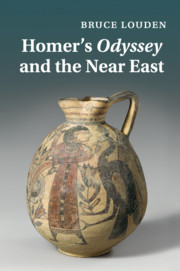Book contents
- Frontmatter
- Contents
- Acknowledgements
- Introduction
- 1 Divine councils and apocalyptic myth
- 2 Theoxeny
- 3 Romance
- 4 Odyssey 4
- 5 Odyssey 5
- 6 Odyssey 6–8, 10–12, 13.1–187; Genesis 28–33; Argonautic myth
- 7 Odysseus and Jonah
- 8 The combat myth
- 9 Catabasis, consultation, and the vision
- 10 Thrinakia and Exodus 32: Odysseus and Moses
- 11 The suitors and the depiction of impious men in wisdom literature
- 12 Odysseus and Jesus
- 13 Contained apocalypse
- Conclusion
- Bibliography
- Index locorum
- Subject index
9 - Catabasis, consultation, and the vision
Odyssey 11, 1 Samuel 28, Gilgamesh 12, Aeneid 6, Plato's Allegory of the Cave, and the Book of Revelation
Published online by Cambridge University Press: 04 February 2011
- Frontmatter
- Contents
- Acknowledgements
- Introduction
- 1 Divine councils and apocalyptic myth
- 2 Theoxeny
- 3 Romance
- 4 Odyssey 4
- 5 Odyssey 5
- 6 Odyssey 6–8, 10–12, 13.1–187; Genesis 28–33; Argonautic myth
- 7 Odysseus and Jonah
- 8 The combat myth
- 9 Catabasis, consultation, and the vision
- 10 Thrinakia and Exodus 32: Odysseus and Moses
- 11 The suitors and the depiction of impious men in wisdom literature
- 12 Odysseus and Jesus
- 13 Contained apocalypse
- Conclusion
- Bibliography
- Index locorum
- Subject index
Summary
Book 11 of the Odyssey combines three distinct genres of myth, catabasis (or the descent to the underworld), consultation with the shade of a deceased prophet, and the vision. Catabasis, a particularly common mythic genre in Greek myth, survives in several other examples. Both the Iliad (8.363–9) and the Odyssey (11.623–6) refer to Herakles' descent (cf., Bacchylides Ode 5.56–175), performed as his final labor for Eurystheus. Orpheus and Theseus also made descents to the underworld, though not mentioned in Homeric epic. But in having Odysseus sail to Hades, the Odyssey subordinates catabasis under the framework of the fantastic voyage, explored in Chapter 7. In having Kirke require Odysseus' voyage to the underworld, the Odyssey simultaneously subordinates its consultation under the framework of Argonautic myth which not only shapes much of Books 6–12, but surfaces again in Book 11 in the Catalogue of Women (Od. 11.225–329).
Perhaps because of these two factors, the Odyssey largely dispenses with any real depiction of the catabasis, as it would later appear in Book 6 of the Aeneid. Instead, with typically Homeric economy, the episode (after the surprising appearance of Elpenor) quickly focuses on Odysseus' meeting with Teiresias (Od. 11.90–151), the reason Kirke ordered the trip to Hades (Od. 10.490–5). The hero's consultation, as directed by Kirke, with a legendary deceased prophet finds a close parallel in Old Testament myth's account of Saul consulting Samuel (1 Sam. 28) with the help of the unnamed female necromancer.
- Type
- Chapter
- Information
- Homer's Odyssey and the Near East , pp. 197 - 221Publisher: Cambridge University PressPrint publication year: 2011



